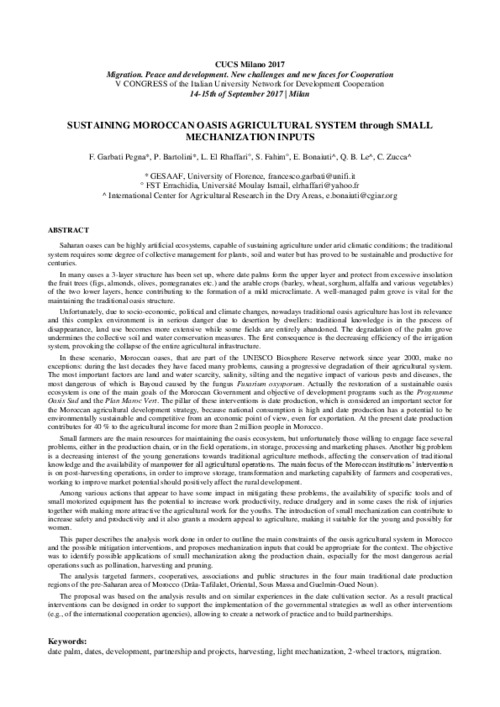Sustaining Moroccan Oasis Agricultural System through Small Mechanization Inputs
Abstract
Saharan oases can be highly artificial ecosystems, capable of sustaining agriculture under arid climatic conditions; the traditional
system requires some degree of collective management for plants, soil and water but has proved to be sustainable and productive for
centuries.
In many oases a 3-layer structure has been set up, where date palms form the upper layer and protect from excessive insolation
the fruit trees (figs, almonds, olives, pomegranates etc.) and the arable crops (barley, wheat, sorghum, alfalfa and various vegetables)
of the two lower layers, hence contributing to the formation of a mild microclimate. A well-managed palm grove is vital for the
maintaining the traditional oasis structure.
Unfortunately, due to socio-economic, political and climate changes, nowadays traditional oasis agriculture has lost its relevance
and this complex environment is in serious danger due to desertion by dwellers: traditional knowledge is in the process of
disappearance, land use becomes more extensive while some fields are entirely abandoned. The degradation of the palm grove
undermines the collective soil and water conservation measures. The first consequence is the decreasing efficiency of the irrigation
system, provoking the collapse of the entire agricultural infrastructure.
In these scenario, Moroccan oases, that are part of the UNESCO Biosphere Reserve network since year 2000, make no
exceptions: during the last decades they have faced many problems, causing a progressive degradation of their agricultural system.
The most important factors are land and water scarcity, salinity, silting and the negative impact of various pests and diseases, the
most dangerous of which is Bayoud caused by the fungus Fusarium oxysporum. Actually the restoration of a sustainable oasis
ecosystem is one of the main goals of the Moroccan Government and objective of development programs such as the Programme
Oasis Sud and the Plan Maroc Vert. The pillar of these interventions is date production, which is considered an important sector for
the Moroccan agricultural development strategy, because national consumption is high and date production has a potential to be
environmentally sustainable and competitive from an economic point of view, even for exportation. At the present date production
contributes for 40 % to the agricultural income for more than 2 million people in Morocco.
Small farmers are the main resources for maintaining the oasis ecosystem, but unfortunately those willing to engage face several
problems, either in the production chain, or in the field operations, in storage, processing and marketing phases. Another big problem
is a decreasing interest of the young generations towards traditional agriculture methods, affecting the conservation of traditional
knowledge and the availability of manpower for all agricultural operations. The main focus of the Moroccan institutions’ intervention
is on post-harvesting operations, in order to improve storage, transformation and marketing capability of farmers and cooperatives,
working to improve market potential should positively affect the rural development.
Among various actions that appear to have some impact in mitigating these problems, the availability of specific tools and of
small motorized equipment has the potential to increase work productivity, reduce drudgery and in some cases the risk of injuries
together with making more attractive the agricultural work for the youths. The introduction of small mechanization can contribute to
increase safety and productivity and it also grants a modern appeal to agriculture, making it suitable for the young and possibly for
women.
This paper describes the analysis work done in order to outline the main constraints of the oasis agricultural system in Morocco
and the possible mitigation interventions, and proposes mechanization inputs that could be appropriate for the context. The objective
was to identify possible applications of small mechanization along the production chain, especially for the most dangerous aerial
operations such as pollination, harvesting and pruning.
The analysis targeted farmers, cooperatives, associations and public structures in the four main traditional date production
regions of the pre-Saharan area of Morocco (Drâa-Tafilalet, Oriental, Sous Massa and Guelmin-Oued Noun).
The proposal was based on the analysis results and on similar experiences in the date cultivation sector. As a result practical
interventions can be designed in order to support the implementation of the governmental strategies as well as other interventions
(e.g., of the international cooperation agencies), allowing to create a network of practice and to build partnerships

